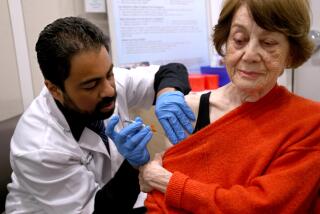The flu season is hitting young people particularly hard. And it’s not over

The emergence of an unlikely strain of influenza has sickened and killed an unusually high number of young people in California this flu season, according to doctors and public health experts.
Most people hospitalized with the flu in Los Angeles County this season have been under 45, said Dr. Jeffrey Gunzenhauser, the county public health department’s chief medical officer. That age group has also made up an unexpectedly large portion of the county’s flu deaths, he said.
“It’s very unusual,” Gunzenhauser said in an interview. “While a lot of people are sick, it’s mostly affecting young people .... It looks like older people are protected.”
Influenza B, the most common strain of flu this season, tends to make more young people sick than influenza A, the virus typically circulating this time of year, experts say. In the United States, it has been nearly 30 years since influenza B was the most prevalent flu virus.
The silver lining, experts say, is that this year’s flu season may be milder overall. Influenza B tends to cause a less severe illness than influenza A, and young people tend to fare better with the flu than older people.
Overall, the flu remains most deadly for the elderly. In California, 105 people have died of the flu so far this season, and more than half were over 65, according to state data released Friday.
Across the state, flu activity jumped in December and has stayed high into January, according to state data. Staff at Southern California hospitals say their emergency departments have been flooded since the holidays with patients complaining of fever, headaches, sore throats and other flu symptoms.
Hospitals trying to manage overcrowding have asked patients not to come to the emergency room unless absolutely necessary and instead go to urgent care centers. At Loma Linda Medical Center in San Bernardino, staff erected a massive tent in the parking lot to triage the influx of flu patients.
Torrance Memorial Medical Center increased emergency room staffing levels and opened extra treatment areas to deal with the high volume of people needing treatment for the flu and other winter colds, said Dr. Eric Nakkim, co-medical director of the hospital’s ER.
“We’ve already seen more flu patients this season than we did all of last season,” Nakkim said.
At UCLA’s emergency rooms, patients of all ages are testing positive for the flu, said ER physician Dr. Lisa Dabby. But people under 24 are showing up much more often than other age groups, suggesting the wide spread of the less common virus, according to a university memo.
“Influenza B is predominating this season,” Dabby said.
It’s unclear why influenza B is more likely to make younger people sick. Some experts believe that since influenza B doesn’t mutate as much as other flu strains, older people may have some immunity to it because they have probably caught it before.
Though doctors are reporting large numbers of people testing positive for the flu, the illness doesn’t appear to be escalating into a life-threatening menace as it has in past years, Gunzenhauser said. In L.A. County, rates of flu deaths and hospitalizations are lower than in recent flu seasons, so there’s hope for a milder season overall, he said.
“Fingers crossed,” Gunzenhauser said.
Still, doctors warn that parents should be mindful of serious flu complications in children. In September, a 4-year-old girl in Riverside County died of the flu. A school-age child in Placer County died of the flu last month.
At Children’s Hospital Los Angeles, doctors have been treating not just routine flu cases, but dangerous problems linked to the flu, including pneumonia and brain swelling, said Dr. Pia Pannaraj, pediatric infectious diseases specialist. These patients who need to be admitted to the hospital often have influenza B, she said.
“We’ve definitely seen quite a rise in children presenting with flu,” Pannaraj said.
In total, five children in California have died of the flu this season, according to state data. Nationwide, 39 children have died of the flu, according to federal data released Friday.
Officials recommend the flu shot for anyone over 6 months old. The shot tends to work better on children, so it’s particularly vital during this flu season disproportionately affecting youth, experts say.
Children tend to be vectors for diseases, including the flu, because they spend time in crowded classrooms and don’t always wash their hands, experts say. Even if the flu shot doesn’t protect against a virus completely, it typically makes the illness less severe, experts say.
“Because children are the ones that are spreading influenza around the community, if they are protected against the flu, they can’t spread it to other people,” Pannaraj said.
Though there was an increase in flu cases around the holidays, it’s impossible to know whether the season has peaked. The flu season officially runs from October through May and typically peaks in January or February.
“Just because we are sort of deep into flu season doesn’t mean people can’t still get the flu shot,” said Dr. Nicholas Testa, chief physician executive overseeing six Dignity Health hospitals in Southern California. “Even if it peaks this week, next week or in two weeks, that doesn’t mean it’s over.”
Indeed, an influenza A strain that had been circulating alongside influenza B seems to have picked up steam in recent weeks. The strain, known as H1N1, began showing up more often in flu tests last week in some parts of the state, state data reveals.
People can contract multiple flu strains in the same season, public health officials warn.
H1N1 tends to cause less severe illness than other A strains, like H3N2, which two years ago caused one of the most severe flu seasons in California in recent memory. Like influenza B, H1N1 also tends to affect younger people more than older adults, according to Gunzenhauser.
The available flu vaccine is a very good match for the H1N1 strains that are increasingly spreading, he said. The vaccine not only protects the person who gets it, but also prevents that person from spreading the flu to people who may not be healthy enough to recover from the illness, he said.
“It should be very effective for what we’re likely to see the rest of the season,” he said. “If people haven’t gotten it — they should just get their shot today.”
More to Read
Sign up for Essential California
The most important California stories and recommendations in your inbox every morning.
You may occasionally receive promotional content from the Los Angeles Times.











